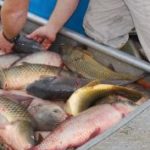
Federally-stocked fish is hated by anglers
It seems that few people, at least in the United States, have much use for the common carp, Cyprinus carpio. But in its native lands, Europe and Asia, it is loved and esteemed. It has been cultivated over 4,000 years in Asia and loved in Europe for nearly 2,000 years. But before the 1870s, there were none in North America.
The fish does have history. It was given its scientific name by Carl Linnaeus, the Swedish naturalist who invented the naming system we still use today for plants and animals. Cyprinus is Greek and carpio is Latin. Both names mean “carp,” so one can assume that our carp is the carp of all carps, and there are a lot of different carps in the world.
Their family, Cyprinidae, is commonly known as the minnow family and includes all the myriad species of freshwater shiners, including the one most often sold as bait, the golden shiner. So now you know; common carp, the one we usually call German carp or just plain carp, is nothing more than a big ol’ overgrown minnow.
They have become despised minnows in this country — literally poster boys for the evils of invasive species, as plants and animals introduced from another area are called nowadays. The knock on them is that in their new land, their population explodes because they have left their diseases and predators behind, and they upset the “balance of nature,” crowding out native species.
Examples are abundant — nutria in our marshes and silver, bighead and grass carp in our fresh waters. Not all exotic species are animals. Some of the more damaging ones are plants such as tallow trees, water hyacinths, salvinia and hydrilla. But the common carp was first and so serves as the emblem of ecological evil.
The story of how they got to this country is enlightening. We worked hard to pull it off. While there is some evidence of a private individual in California bringing in some of these highly thought of fish in 1872 for a private farming operation, most people give all the credit to our federal government.
In 1871, the U.S. Congress authorized President Ulysses S. Grant to appoint an independent body, the U.S. Fish Commission, to investigate declines in commercial fish and aquatic animals in inland and coastal waters. They were to recommend methods to restore populations to Congress and the states and oversee those efforts.
They promptly decided to investigate what species could be introduced to increase fish numbers in the country. By 1874, they issued a report, Fishes Especially Worthy of Cultivation, that listed our hero, the common carp, as being the fish most worthy of introduction.
They followed this in 1876 with a listing of all the species’ admirable qualities, including its high fecundity (egg production), hardiness, rapid growth, ability to live in degraded waters and its fine table qualities. They nailed all of them (the very qualities that make it such a formidable pest) but the last one. Its flesh is full of tiny hair-like bones, and it has a muddy, strong taste.
In 1877, the commission imported 345 scaled, mirror and leather carp. These are all of the same species, but the mirror carp has only a few very large scales scattered on an otherwise leathery skin, and the leather carp is scaleless. (In the early 1960s, I actually caught a mirror carp in Bayou Sara Creek in West Feliciana Parish.)
The fish were stocked in ponds in Maryland and Washington, D.C., and they went to doing what carp do so well — making little carp. The U.S. Fish Commission immediately began distributing these coveted jewels. In 1883, they sent 260,000 of them to 9,872 applicants in 298 of the country’s 301 congressional districts. Congressman carefully watched the process to make sure that their districts weren’t left out in the distribution of the wonder fish.
Soon carp populations exploded, and the fish were blamed for muddying water with their sucker cup mouths while rooting in the bottom for food and for physically displacing more desirable native fishes by their sheer numbers. The promised commercial fishery came and went. The fish just weren’t that good to eat. Wading through the tiny bones wasn’t worth the poor-tasting and dark flesh.
Sportsmen found them to be disappointing. They refused to take artificial lures, preferring instead baits like corn, worms and dough balls. And they were smart and hard to catch.
When I was a youngster, a small slaughterhouse discharged directly into a river that I used to fish. Huge numbers of carp would gang up near the discharge.
We would sneak to casting distance (if we made any noise at all, they wouldn’t bite.) and make simultaneous casts with worm-baited hooks. Everyone got a hook up — then that was it. Not another fish would touch a bait after the first cast, no matter how long we waited. They were there; we could see them. But they knew we were there too and wouldn’t bite.
Carp are least wary during their early spring spawning season. When water temperatures reach 59 degrees, ripe adults will congregate in waters so shallow that their backs are exposed and wallow shamelessly like pigs. Females will spawn from 50,000 to 2 million eggs depending on the size of the fish.
In captivity, carp have been recorded to live to 47 years, although few in the wild live more than 15 years. In the wild they eat almost anything: water insects, worms, snails, fish eggs, algae, plants and plant seeds. Most of their food is grubbed out of the bottom with their rubbery, extendable mouths. They suck up a gob of mud, spit it out and grab the goodies that float free.
Carp are powerful fighters, probably better than any freshwater game fish, including smallmouth bass. They grow large as well. Louisiana’s official record is a 35-pounder, taken in Bussy Brake in 1981. But they grow much larger. The IGFA world record is 75 pounds, 11 ounces, and fish over 80 pounds are reported to have been netted.
For some reason, populations of common carp have declined severely in Louisiana over the last two decades, and no one is sure why. All our research dollars were spent on trying to figure out a way to get rid of them, not keep them around.




